
The long-tailed broadbill is a species of bird that is found in the Himalayas, extending east through Northeastern India to Southeast Asia. It is the only bird in the genus Psarisomus. The long-tailed broadbill is about 25 cm (10 inches) in length and weighs between 50 and 60 grams. It can be identified by its shrill call.
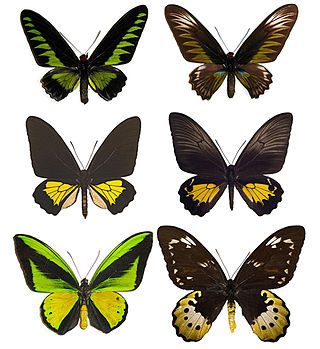
Birdwings are butterflies in the swallowtail family, that belong to the genera Trogonoptera, Troides, and Ornithoptera. Most recent authorities recognise 36 species, however, this is debated, and some authorities include additional genera. Birdwings are named for their exceptional size, angular wings, and birdlike flight. They are found across tropical Asia, mainland and archipelagic Southeast Asia, and Australasia.

Trogonoptera brookiana, Rajah Brooke's birdwing, is a birdwing butterfly from the rainforests of the Thai-Malay Peninsula, Borneo, Natuna, Sumatra, and various small islands west of Sumatra. The butterfly was named by the naturalist Alfred Russel Wallace in 1855, after James Brooke, the Rajah of Sarawak. The larval host plants are Aristolochia acuminata and A. foveolata. Adults sip flower nectar from plants such as Bauhinia. Rajah Brooke's birdwing is a protected species, listed under Appendix II of CITES, meaning that international export is restricted to those who have been granted a permit. It is the national butterfly of Malaysia.

The great argus, or greater argus, is a large species of pheasant from Southeast Asia. It is known for its impressive plumage and courtship behavior. It is not to be confused with the two species of closely related crested argus, genus Rheinardia.

The green broadbill also known as the lesser green broadbill is a small bird in the family Calyptomenidae. It was formerly classified in the family Eurylaimidae, a group of closely related birds that share the name "broadbill".
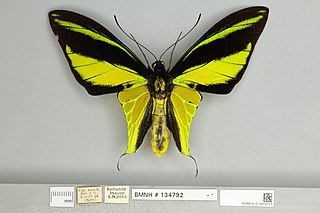
Ornithoptera meridionalis, the southern tailed birdwing, is the smallest species of the genus Ornithoptera. It is known from a handful of localities in southeast Papua, New Guinea and several localities along the south coast of Irian Jaya.

Troides magellanus, the Magellan birdwing, is a large and striking species of birdwing butterfly found in the Philippines and on Taiwan's Orchid Island.
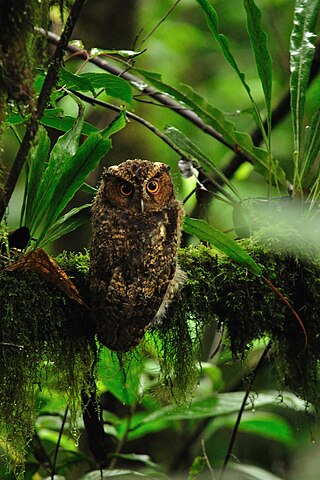
The Rajah scops owl is a species of owl found on the islands of Borneo and Sumatra. The bird is named after James Brooke, Rajah of Sarawak. Based on patterns of speciation in other endemic montane bird species of the same region, it may potentially have to be split into two distinct species; if so, the name Otus brookii would be restricted to just the Bornean population.

Hose's broadbill is a species of bird in the family Calyptomenidae. It was described by the British naturalist Richard Bowdler Sharpe in 1892 and is named after the British zoologist Charles Hose, who collected the holotype of the species. It is 19–21 cm (7.5–8.3 in) long, with females weighing 92 g (3.2 oz) on average and males weighing 102–115 g (3.6–4.1 oz). Males are bright green and have conspicuous black spots on the wings, black markings on the head, blue underparts, black flight feathers, and a large green tuft covering most of the bill. Females have smaller forehead tufts, lime-green underparts with sky blue instead of azure blue on the undertail coverts, and lack black markings on the head, except for a black spot in front of the eye.

Whitehead's broadbill is a species of bird in the family Calyptomenidae. It is endemic to the mountain ranges of north-central Borneo, where it mainly inhabits montane forests and forest edges at elevations of 900–1,700 m (3,000–5,600 ft). It is 24–27 cm (9.4–10.6 in) long, with males weighing 142–171 g (5.0–6.0 oz) and females weighing 150–163 g (5.3–5.7 oz). Males are vivid green and have a black throat patch, black spots on the ear-coverts and back of the neck, and black markings and streaking all over the body. The tails and flight feathers are also blackish. Females are smaller and lack the black markings on the head and underparts. Juveniles look similar to adults but have fewer black markings.

The black-and-red broadbill is a species of bird in the typical broadbill family, Eurylaimidae. It is the only species in the genus Cymbirhynchus. A large, distinctive bird, it has maroon underparts, black upperparts, a maroon neck-band, and white bars on the wings. It also has a large, two-colored, blue-and-yellow bill. The species shows slight sexual dimorphism, with females being smaller than males. No other bird in its range resembles it, though the black-and-yellow broadbill has a similar call.

The banded broadbill is a species of bird in the Eurylaimidae typical broadbill family found in Mainland Southeast Asia and the Greater Sunda Islands. It is sometimes split into two species, one including only the nominate subspecies, E. j. javanicus, and one including all the remaining subspecies. It inhabits a variety of forests, along with forest edge, rubber plantations and Falcataria falcata groves, mainly in lowland areas. A striking, large-bodied bird with a length of 21.5–23.0 cm (8.5–9.1 in), it is unlikely to be mistaken for another species. The broadbill is mostly purplish-red, with yellow-streaked black wings, a bright blue beak, a blackish face and greyish chin and upper breast. Females can be told apart from males by their lack of a black neckband, although these are indistinct in Bornean and Javan males. Despite its conspicuous appearance, the bird is usually hard to see due to its sluggishness and is usually only noticed when it vocalises.

The black-and-yellow broadbill is a species of bird in the typical broadbill family Eurylaimidae. A small, distinctive species, it has a black head, breastband, and upperparts, a white neckband, yellow streaking on the back and wings, and vinous-pink underparts that turn yellow towards the belly. The beak is bright blue, with a green tip to the upper mandible and black edges. It shows some sexual dimorphism, with the black breastband being incomplete in females.
Rajah or Raja is a monarch or princely ruler in South and Southeast Asia.
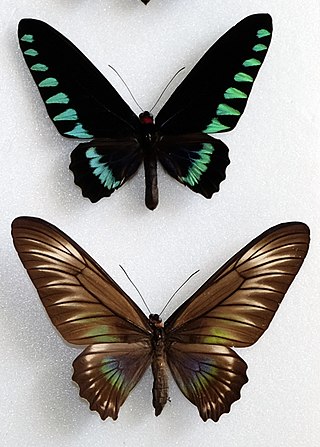
Trogonoptera trojana, the Palawan birdwing or triangle birdwing, is a birdwing butterfly of the family Papilionidae. It is endemic to Palawan in the Philippines. It is one of only two species in its genus, the other being the more widespread Rajah Brooke's birdwing, where the male has larger green markings on the hindwings. This species is included in CITES Appendix II, restricting international export to those who have been granted a permit. The wingspan is approximately 18–19 cm (7.1–7.5 in). The species may be observed flying at any point during the year. The larvae feed on Aristolochia.

Perdana Botanical Gardens, formerly Perdana Lake Gardens, Lake Gardens and Public Gardens, is Kuala Lumpur's first large-scale recreational park. Measuring 91.6 hectares, it is located in the heart of the city and established in 1888. The park served as place of refuge from the hustle and bustle of the city during colonial times. It contains large sculpted and manicured gardens and a host of attractions.

Troides amphrysus, the Malay birdwing, is a birdwing butterfly in the genus Troides in the family Papilionidae.
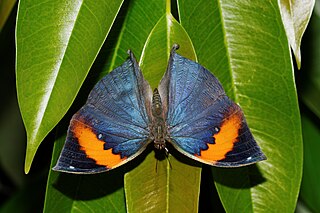
Kallima paralekta, the Indian leafwing or Malayan leafwing, is a species of brush-footed butterfly of the genus Kallima. Despite its common names, it is not found in India or Malaysia, but is endemic to Java and Sumatra in Indonesia. Like other members of its genus, it is remarkable for its strong resemblance to a dead leaf when its wings are folded. It was one of the species encountered by the British naturalist Alfred Russel Wallace in his travels in maritime Southeast Asia. It is mentioned in his famous 19th-century work The Malay Archipelago as one of the best examples of protective camouflage achieved through natural selection.

Ulu Temburong National Park is the first national park to be established in Brunei, protected since 1991. The park is in Temburong District in eastern Brunei, and covers about 40% of the district in the south at 550 square kilometres (210 sq mi). It is within the Batu Apoi Forest Reserve. The park contains unspoiled jungle and is known as the "Green Jewel of Brunei", described as "the finest example of the sultanate's successful forest protection policy". The principal rivers are the Temburong and Belalong Rivers. It is an important ecotourism centre in Brunei and hosts the Ulu Ulu Resort. The Peradayan Forest Reserve is also located in the district.
Sarawak People's Aspiration Party is a political party based in Sarawak, Malaysia, renamed and rebranded from previously State Reform Party abbreviated STAR.


















